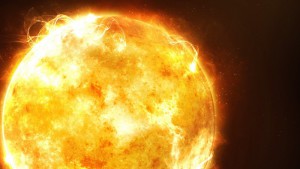
Scientists at Imperial College of London (UK) developed a new method that could allow lasers to heat certain materials to temperatures hotter than at the Sun’s core in 20 quadrillionths of a second.
With its promise of cheap, limitless energy, fusion power is the holy grail of energy production. Unfortunately, in order to make fusion reactors practical, it’s necessary to recreate conditions and processes similar to those found in the interior of the Sun. For engineers and scientists using lasers to achieve this goal, one of the stumbling blocks is how to rapidly heat a target to incredibly high temperatures.
According to the Imperial College team, the answer isn’t simply a matter of hitting a target with more and more powerful lasers. It requires addressing how the material heats up. In the sort of high temperature plasma environment that fusion occurs, how a laser heats something is a complex process where the laser beam heats up the electrons in a material, which then heat the ions that make up most of the material’s mass. It works, but it’s relatively slow.
What the Imperial College team wanted was to cut out the electrons and heat the ions directly. According to Dr Arthur Turrell, they made the unexpected discovered that if certain kinds of materials are struck by a high-intensity laser, they generate what is called an electrostatic shock wave.
That in itself isn’t new, but previously all such shockwaves did was push the ions in front of them without any heating effect. However, the team found through sophisticated supercomputer modeling that high density materials, such as plastic or caesium hydride, have a special combination of ions that are accelerated at different speeds and this produces a kind of friction, where a single sort of ion doesn’t. Because the material has a high density, the ions are squeezed together by the shock wave by a factor of 10, which adds to the friction effect.
“The two types of ions act like matches and a box; you need both,” says Dr Mark Sherlock of the Department of Physics at Imperial. “A bunch of matches will never light on their own – you need the friction caused by striking them against the box.”
So far, the Imperial College technique is strictly theoretical and has only been tried in computer models, but these indicate it would be able to heat small amounts of solid matter to temperatures in the region of 11.6 million degrees Celsius (20.8 million° F) in tens of femtoseconds, or less than a million millionth of a second. The challenge now is to prove the technique experimentally, which is something the team is confident can be achieved. If so, the team says it would be the fastest heating rate ever achieved in a lab for a significant number of particles and would have a major impact on fusion research and applications.
“Faster temperature changes happen when atoms smash together in accelerators like the Large Hadron Collider, but these collisions are between single pairs of particles,” said Dr Turrell. “In contrast the proposed technique could be explored at many laser facilities around the world, and would heat material at solid density.”
Source: Gizmag



